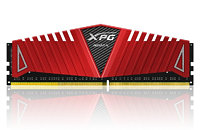Thursday, August 7th 2014

ADATA Launches XPG Z1 DDR4 Overclocking Memory
ADATA Technology, a leading manufacturer of high-performance DRAM modules and NAND Flash application products, today launches the first DDR4 overclocking memory of XPG series - XPG Z1, which supports the latest Intel Haswell-E platform for ultimate performance. With the benefits of DDR4, the XPG Z1 is not only a powerful weapon for gaming, also an important component for overclocking.
Performance Boosts with Great Power Efficiency
DDR4 outperforms DDR3 with improved performance and lower power consumption. The operating voltage has decreased from 1.5V to 1.2V, which is a 20% reduction of power, and keeps the system at a low temperature for stable operation. With speeds of up to 2800 MHz, timings of CL 17-17-17 and transfer bandwidth reaching 22 GB/s, the XPG Z1 provides improved efficiency of data transfer than ever. It only requires 1.2V to achieve high clock frequency of 2800 MHz for overclockers. In addition, the SPD (Serial Presence Detect) of XPG Z1 allows direct application without changing settings in the BIOS, facilitating usage and system stability.Looks cool, Acts cool
The XPG Z1 features a jet wing-inspired design with carbon texture used for race cars, symbolizing the pursuit of extreme performance. Thanks to the unique Thermal Conductive Technology and 10-layer PCBs with 2oz copper, the chips in XPG Z1 can contact with the heat sinks directly, ensuring IC and PCB operate in an environment of equal temperature, as well as reduce electric resistance and consume less power, which greatly enhances the quality of signal transfer.
The Maximum Durability and Assurance
The XPG Z1 DDR4 DRAM Module is made of high-quality chips selected through a strict filtering process. It also uses the top quality PCBs (Printed Circuit Board) that effectively extend the lifespan of memory modules. Additionally, ADATA memory modules provide customers a lifetime warranty for the maximum assurance with excellent service.
Performance Boosts with Great Power Efficiency
DDR4 outperforms DDR3 with improved performance and lower power consumption. The operating voltage has decreased from 1.5V to 1.2V, which is a 20% reduction of power, and keeps the system at a low temperature for stable operation. With speeds of up to 2800 MHz, timings of CL 17-17-17 and transfer bandwidth reaching 22 GB/s, the XPG Z1 provides improved efficiency of data transfer than ever. It only requires 1.2V to achieve high clock frequency of 2800 MHz for overclockers. In addition, the SPD (Serial Presence Detect) of XPG Z1 allows direct application without changing settings in the BIOS, facilitating usage and system stability.Looks cool, Acts cool
The XPG Z1 features a jet wing-inspired design with carbon texture used for race cars, symbolizing the pursuit of extreme performance. Thanks to the unique Thermal Conductive Technology and 10-layer PCBs with 2oz copper, the chips in XPG Z1 can contact with the heat sinks directly, ensuring IC and PCB operate in an environment of equal temperature, as well as reduce electric resistance and consume less power, which greatly enhances the quality of signal transfer.
The Maximum Durability and Assurance
The XPG Z1 DDR4 DRAM Module is made of high-quality chips selected through a strict filtering process. It also uses the top quality PCBs (Printed Circuit Board) that effectively extend the lifespan of memory modules. Additionally, ADATA memory modules provide customers a lifetime warranty for the maximum assurance with excellent service.

12 Comments on ADATA Launches XPG Z1 DDR4 Overclocking Memory
It will be faster than what we have now. This is only the start of DDR4.
I expect to see some Wazoo Performance gains with it, and I'm looking forward to using it.
That being said DDR4 offers almost nothing in tangible system performance for CPU powered desktop PCs because DDR3 running at 1600 Mhz. has been shown over and over and over to NOT be a system bottleneck.
That means if you use faster RAM than 1600 MHz. with a currently available desktop CPU, you get no tangible gain in system performance because the only gain is the minute change in real time associated with the higher frequency. If DDR3 running at 1600 MHz. was saturated then faster RAM could show large gains but the RAM frequencies far exceed the system needs for CPU powered desktops. For APU powered desktops RAM up to 2133 MHz. shows a modest value in system performance.
You can run the tests yourself as many people have done and see that the higher RAM frequencies be they DDR3 or DDR4 (which is designed for servers, not desktop PCs), there is no tangible system performance gains and as such it's a waste of money other than for bragging rights.
en.wikipedia.org/wiki/DDR3_SDRAM
On my Athlon 760K
www.techpowerup.com/forums/threads/comparisons-of-cpu-gpu-ram-overclocks-and-comparing-bottlenecks-fm2-cpu.196940/
And my FX-4100
www.techpowerup.com/forums/threads/update-on-my-fx-4100-more-tuning-performance.161062/
I have to really analyze what I'm spending my cash on beforehand and justify it to myself. If I want something badly enough, I sell some of my gear and add a little of my money to afford it.
I don't buy into new technology before others have it, and have reported on it's merits and shortcomings.
So I'll probably sit out DDR4 memory for a while to see if it really matters.
Whether or not it's a show stopper/game changer, the systems that I have now are pretty cool, and I don't HAVE to change a thing to enjoy my games.